1969 Canadian Grand Prix race report: Ickx’s dice doubles return
Brabham’s Jacky Ickx survives some ontrack push and shove with Jackie Stewart to win his second race of the season
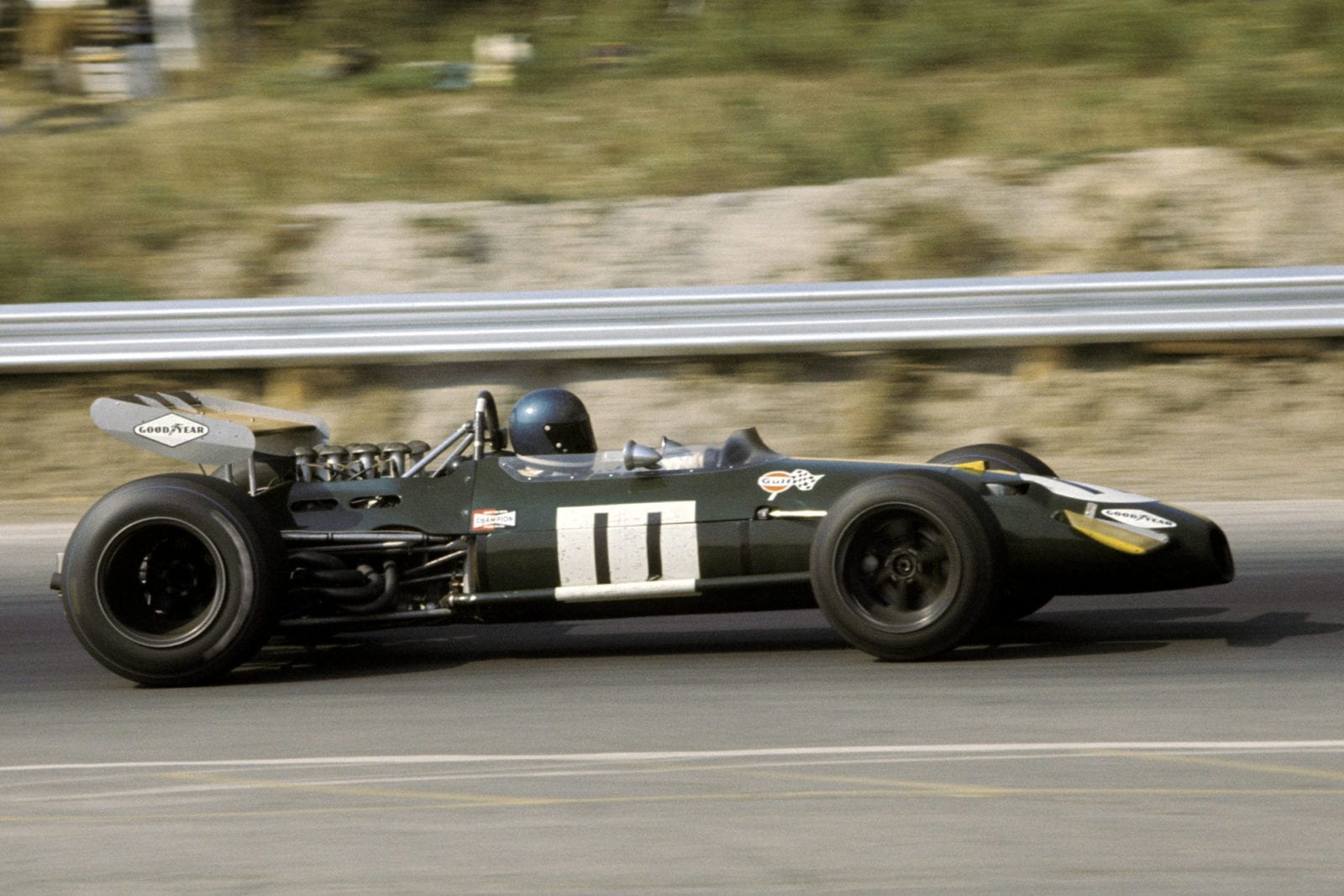
Jacky Ickx took his second win of the season for Brabham in Canada
Motorsport Images
The World Championship Grand Prix series is gradually becoming truly world-wide, the recently introduced Canadian Grand Prix extending the North American list to three events. Held at Mosport Park, near Toronto, the Canadian race organisers attracted a full field from Europe, and the addition of three local drivers made the entry list up to 20, the largest field seen this year in Formula One racing.
Following the lead set by the organisers of the United States Grand Prix in previous years, the Canadians offered large prize money in place of starting-money, the prize list extending right down to 20th place, so that anyone unfortunate enough to retire on the starting line was assured of sufficient money to cover his expenses. Although the total sum was not as high as that offered by Watkins Glen, it was sufficient to attract full works and private support from Europe.
“Having clinched the World Championship, Stewart was already commercialising his position, perhaps forgetting that Graham Hill is still reigning World Champion”
With the World Championship already won by Stewart, the Matra International team could relax slightly and reduce their 100 % concentration on the Scots driver, spreading their effort further afield, but this is not to suggest that they had any less ambition to win the Canadian Grand Prix anyway. What it allowed them to do was to run three cars, MS80-02 for Stewart, MS80-01 for Beltoise, and the four-wheel-drive MS84 for Servoz-Gavin, this time the young blond Frenchman being a certain starter, unlike the entry at Monza.
During this season Servos-Gavin has been driving well in the Matra Formula Two team and he was very pleased to get back in the 400bhp category of Formula One. Having clinched the 1969 World Championship at Monza in September, Stewart was already commercialising on his position, perhaps forgetting that Graham Hill is still the reigning World Champion, and remains so until the end of the 1969 season.
However, Stewart’s promotional publicity was aimed at helping the race organisers and after much pre-race publicity a crowd of 40,000 drove out to the rural surroundings of Mosport Park. The Gold Leaf Team Lotus trio of two Type 49B cars and a lone four-wheel-drive Type 63, were similar to the trio that ran at Monza. Hill and Rindt had the two-wheel-drive cars and Miles the four-wheel-drive car. The normal cars were those raced at Monza, 49/10 for Hill and 49/6 for Rindt, and Miles had 63/2.
Another three-car team was that of the Owen Racing Organisation, with three BRM cars, P139-01 for Surtees, P139-02 for Oliver, as they had been at Monza, and the earlier car P138-01 which was loaned to Canadian Lotus-dealer Bill Brack, although it was understood that it was in reality a spare car for the works drivers. Brabham and Ickx had the same cars they used at Monza, the owner in 26/4 and the young Belgian driver in 26/3, while Courage was supporting the Brabham ranks as usual with the Frank Williams car 26/1.
McLaren and Hulme had their normal two cars, the former in M7C/1 and the latter in M7A/2. The Ferrari entry was very half-hearted, being a lone car for Rodriguez, entered by the North American Racing Team of Luigi Chinetti and looked after by his mechanics. It was 0017, with the 1968/69 type of engine as used at Monza, with central exhaust system and inlets on the outside of the vee of the engine. The new flat-12-cylinder car did not appear, still being on test in Modena, and still proving to be a bit fragile.
The rest of the entry was made up by private owners, Siffert with the Walker/Durlacher Lotus, the American driver Lovely with the Lotus 49B he purchased earlier this year, Moser with his Brabham-Cosworth V8 and two rather outclassed cars driven by Canadian drivers. One was basically a 1967 Formula Two Brabham, fitted with a 2.7 litre Coventry-Climax engine, and the other was the original AAR-Eagle, also Climax powered.
The Brabham was driven by John Cordts, whose experience has been mostly in Can-Am racing, and the Eagle was owned and driven by Al Pease, who seemed to lack sufficient racing experience to be in with a field of top-flight Grand Prix drivers.
The Mosport Park circuit is built on sandy and hilly ground some 50 miles from Toronto and its 2½ miles twist and turn, climb and fall through the wooded territory, making an interesting and quite fast track. In a way it resembles Oulton Park and many of the corners have adverse cambers, which keep drivers on their mettle and do not allow for mistakes.
The facilities are not on a grand scale, but are adequate, and have been limited by financial troubles which at one stage looked as though they might cause the circuit to be closed down. However, things have improved recently and the circuit and organisation now seem to be running smoothly.
Qualifying
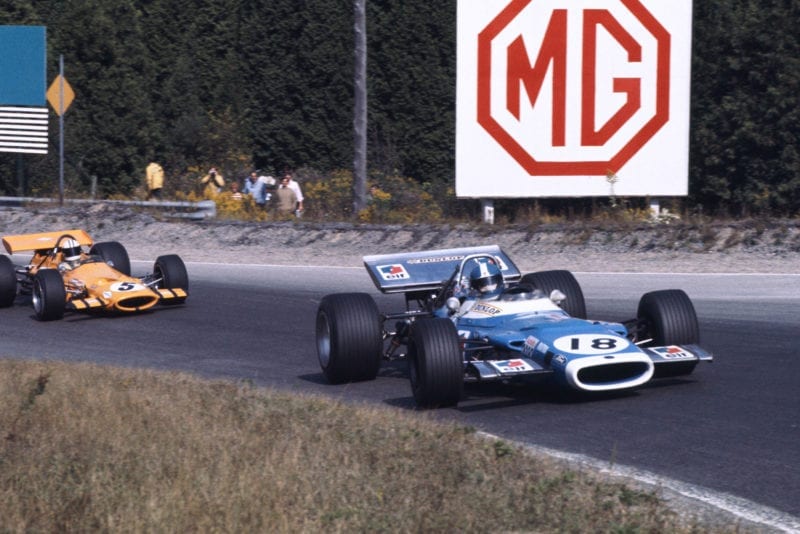
Jean-Pierre Beltoise took 2nd on the grid in his Matra
Motorsport Images
With the race being held on Saturday, September 20th, over 90 laps of the 2.459-mile circuit, practice was scheduled for the previous Thursday and Friday, with more than adequate time on both days. The first day was a free-for-all affair with no official timekeepers so that drivers and teams might acclimatise themselves to the circuit and conditions and make final suspension and handling adjustments to the cars before the serious business began on Friday, when lap times would be recorded for grid positions.
The lap record for the Mosport Park circuit was set up by McLaren in a recent Can-Am race, with his 7-litre McLaren Chevrolet V8, with a time of 1min 19.5sec, and though no-one approached this time during the first test-session, according to pit timing, there was little doubt that the lighter and more manageable Grand Prix cars would go faster than the big and heavy Can-Am cars.
During the Thursday practice Rindt tried the 4wd Lotus, which was the second car built, and had been rebuilt after Andretti crashed it at the Nurburgring. Numerous improvements had been carried out during the rebuild, including a redesign of the central gearbox and fore-and-aft control unit for the power take-off.
The track surface was not in good condition, being covered in sand and earth in places, blown there from the loose edges by strong winds, and this rather slippery surface kept speeds down and also was the cause of Rindt having an almighty spin out of the bend before the pits.
However, in the afternoon most of the looseness had been scrubbed off the circuit and unofficial lap times began to improve, Rindt getting well below the record, and Beltoise, Siffert and McLaren being around the record figure. The last named had his engine seize during the morning and some speedy work by his mechanics got a new engine installed for the afternoon practice.
Stewart was not in the running as the Hewland gearbox on his Matra was giving trouble and jumping out of gear. The BRM team were no challenge to the Cosworth-powered cars, though Surtees was unwell and in no state to drive hard, while the lone Ferrari did not even appear.
On Friday the serious business began, with practice becoming official and timekeepers in operation, and it was not long before the Can-Am lap record was made to look pretty sick. Beltoise was going extremely well, having an obvious liking for the circuit, and got down to 1min 17.9sec, with Rindt and Stewart equalling this time.
“Siffert had got his foot caught under the brake pedal, and at racing speeds there is no time for a second attempt at pressing the brake pedal!”
Trying to keep up this pace the little Frenchman overdid things and crashed into a wire-mesh retaining fence, fortunately with no serious damage, and the car was dusted off and made ready for the afternoon practice period.
Siffert was not so lucky, for he lost control on the bend before the pits and crashed heavily into the steel barriers lining the track at this point, and the whole left-side of the car was very badly damaged. The Swiss was not damaged personally, but with both left-hand suspensions virtually torn off the chassis the mechanics had a major repair job on their hands. It seemed that Siffert had got his foot caught under the brake pedal, and at racing speeds there is no time for a second attempt at pressing the brake pedal!
While all this excitement was taking place the Brabham team were quietly getting on with things, their cars being well suited to the nature of the circuit, and Ickx had recorded 1min 18.3sec.
Then Brabham went out in the same car that Ickx had used and put in a lap at 1min 18.0sec and when the afternoon practice session began it was Ickx who set the pace. Quite early on he went round in 1min. 17.4sec, which not only shattered the other Grand Prix contestants but completely demoralised the Can-Am supporters who had been saying that a mere 3-litre Grand Prix car would not beat a 7-litre monster.
No-one looked like approaching the time set by Ickx, only Rindt and Stewart being under 1min 18.0sec., with identical laps at 1min 17.9sec, but these had merely equalled the time set by Beltoise in the morning session. Stewart was thwarted in his efforts when his engine went sick, and he then tried the 4wd Matra, and Rindt also stopped trying to equal Ickx and had a further try with the 4wd Lotus.
Neither of the “aces” went particularly fast in the 4wd cars, and Miles was faster with a time of 1min 20.0sec, which showed that the Lotus 63 has good potential, and Team Lotus were regretting that Andretti could not get away from his USAC commitments to come and drive the car.
None of the other runners were particularly impressive, Hulme and McLaren making equal times at 1min 18.5sec, which no doubt made them wonder what Can-Am was all about, and none of the BRM team could break 1min 20sec, while the Ferrari did nothing more than add colour to a Cosworth field.
The two Canadian private drivers were handicapped by having underpowered machinery, but there was little in their driving to suggest they would have been that much better with V8 engines.
Race
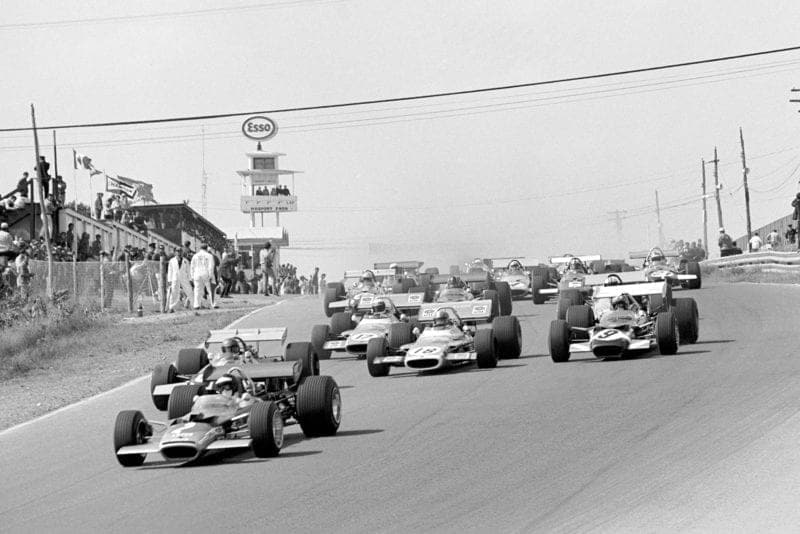
Ickx leads as the race gets underway
Motorsport Images
The Saturday race day was bright and dry and all 20 cars were ready to line up on the grid, with Ickx in pole position, a half-second faster than anyone else, while the next five cars were within one-tenth of a second of each other, which rather indicated that the time-keeping mechanism was not really up to present-day World Championship standards.
Overnight the Matras of Stewart and Servoz-Gavin had been fitted with different engines to those used in practice, as had Brabham’s car. A parade of local officials opened the circuit and then the drivers were taken round on a parade lap in a selection of large American drophead cars, and then the drivers went off on a warm-up lap in the Grand Prix cars, and lined up on the “dummy grid”.
“The future World Champion was not giving way nor allowing any room to spare anywhere”
The first bend after the start is a downhill right-hander and Rindt went down it in the lead, from his advantageous outside position on the front row. During the opening lap Moser got into difficulties avoiding one of the Canadian drivers and spun into the steel barriers causing heavy damage to his car, so that only 19 cars completed the opening lap, with Rindt holding a tenuous lead, with Ickx, Beltoise and Stewart pressing him hard.
Stewart soon got by his team-mate and then tackled Ickx, getting by on lap five, and on the next lap he was by Rindt and out in his accustomed place at the head of the field, a position he has held in every Grand Prix so far this year. On lap eight Ickx was by the Austrian Lotus driver and from then on there was a splendid battle between the Matra and the Brabham, the little Belgian driver trying all he knew to get by the Scot, but the future World Champion was not giving way nor allowing any room to spare anywhere.
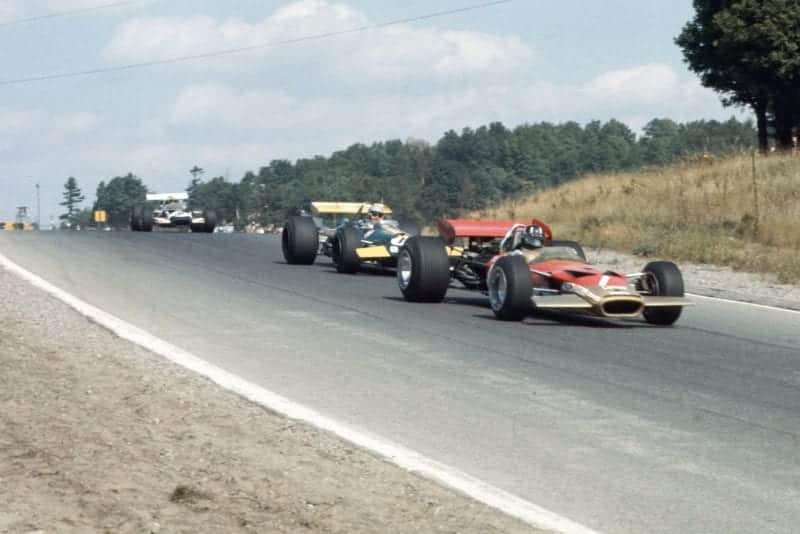
Graham Hill leads
Motorsport Images
For lap after lap these two circulated in very close company, the Brabham driver trying to get his nose in front of the Matra all round the circuit, and they left the rest behind very quickly. Almost unnoticed Oliver had retired on lap three with engine trouble in his BRM, and Hulme went out on lap 10 with a faulty ignition distributor, while one of the “moving chicanes” went out on lap 11 when Cordt’s withdrew with an oil leak.
Rindt could not keep pace with the two leaders, and he in turn was being caught by a fast group comprising Beltoise, Siffert, Brabham and Courage. This quintet had their race completely spoilt when they came up to lap Pease in the old Eagle-Climax, for he was going very slowly and not keeping out of the way. Beltoise actually collided with the Eagle, upsetting something on the Matra suspension, for it did not handle properly afterwards, and as they battled to get by the Eagle it was Brabham who profited and got away, to start closing on Rindt.
“The Stewart-Ickx duel for the lead was continuing unabated and was Grand Prix racing at its best”
Courage was forced out when a fuel bag split and leaked into the cockpit, and Surtees went out unnoticed with engine trouble in the second BRM. Pease was black-flagged and pulled out of the race as he was not going fast enough, and the field was getting very depleted with less than a third of the race run.
The Stewart-Ickx duel for the lead was continuing unabated and was Grand Prix racing at its best, the retirements and troubles behind them being Grand Prix racing at its worst.
On lap 33 Ickx thought he saw his chance of diving through on the inside of Stewart as they went into a left-hand bend, for the Matra driver seemed to hesitate for a fraction of a second in his positioning for the corner. By the time Stewart began to move over on his cornering line it was too late, Ickx had the Brabham alongside and the left rear wheel of the Matra struck the right rear wheel of the Brabham and the two cars spun.
Ickx was able to continue undaunted, but Stewart ended up in a shallow ditch. His engine was stalled and he could not restart it, while the throttle linkage was damaged slightly, so that was the end of his race, and a rather embarrassed young Ickx came round in the lead next lap to see his rival out of the race.
This unfortunate incident, caused by a slight error of judgement on the part of both drivers, saw the end of the race as such, for Ickx was way out on his own and he merely had to reel off the laps until the finish, when he was able to go and apologise to Stewart for the rather unruly “nudging” match that Grand Prix drivers normally do not reckon to indulge in.
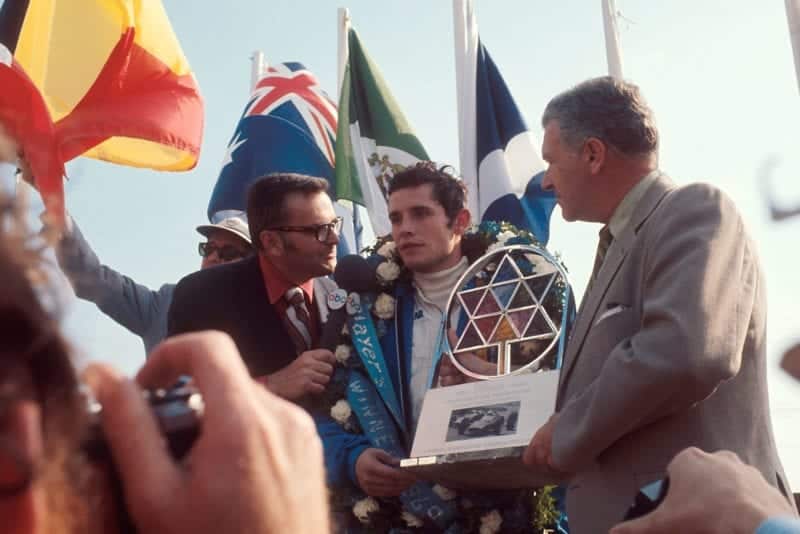
Ickx is interviewed on the podium
Motorsport Images
Behind the Belgian boy his “boss” was being inspired, and was pressing hard on Rindt for second place. The Austrian fought back bravely but it is a strong driver who can withstand the determined pressure of Brabham when the Australian is in a belligerent mood, and ultimately Rindt had to give way and let Brabham go by, even then being unable to keep pace with him.
Behind these two there was no actual race, for Beltoise was a comfortable fourth and McLaren fifth, a long way back, the rest of the serious runners having fallen out. Hill disappeared when the Cosworth engine in his Lotus broke, and Rodriguez went out with no oil pressure in the Ferrari engine. The 4wd Lotus stopped with a seized gearbox, but the Matra 4wd car was still running, Servoz-Gavin eventually bringing it home in sixth place, ahead of Lovely’s Lotus 49 and Brack’s BRM.
Ickx was far from happy at having won the race at the expense of Stewart’s retirement, but the Brabham team were overjoyed with their first and second places, Brabham himself having been in splendid form and making a lot of younger men feel rather foolish. At mid-season Matra seemed to have things tied up when they started two cars in the French GP and finished 1st and 2nd. Now Brabham has done the same thing, and no-one can do better than that.
